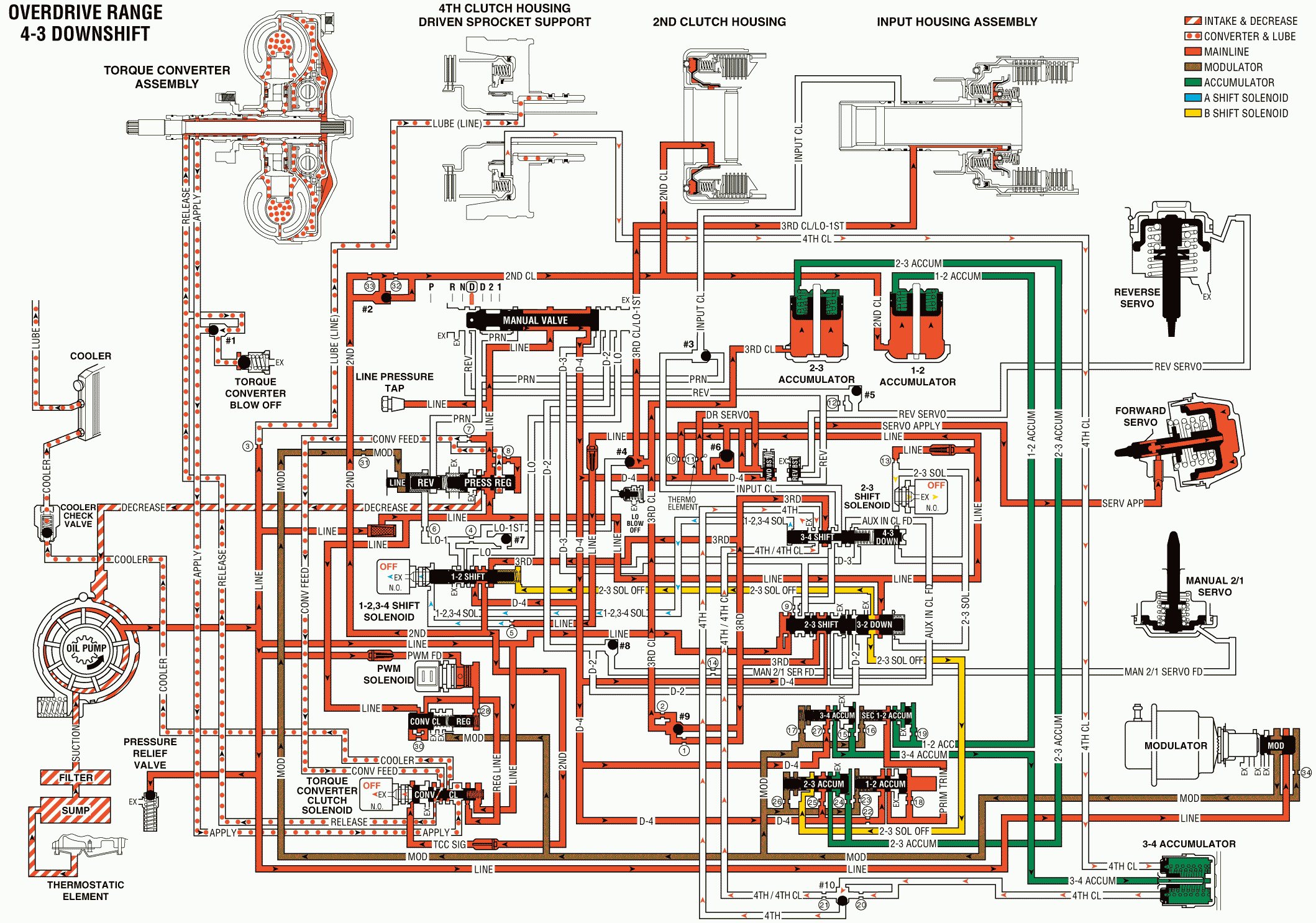Under light throttle acceleration, the torque converter clutch is released when the PCM receives input signals from the VS Sensor and the TP Sensor. These signals regulate the duty cycle of the PWM solenoid in order to achieve a smooth disengagement of the converter clutch. Once this is achieved, the converter clutch solenoid (315) and the PWM solenoid (325) are de-energized (turned OFF). Line pressure and spring force at the converter clutch valve (335) move the valve in order to allow converter feed fluid to enter the release passage. Release pressure seats the #1 checkball (372) against the applied fluid. The release pressure then feeds to the release side of the torque converter clutch plate. Applied fluid in the torque converter (1) is directed through the applied passage to the converter clutch valve (335), where the fluid enters the cooler passage. A 4-3 shift occurs when the PCM de-energizes (turns OFF) current to the 1-2, 3-4 shift solenoid valve (315). This allows the 1-2, 3-4 shift solenoid valve fluid at the 3-4 shift valve (362) to exhaust through the solenoid. A spring force at the 3-4 shift valve (362) moves the valve, which allows fourth clutch applied fluid (at the fourth clutch) to be directed through the following path:
- Through the 3-4 accumulator assembly (421-428)
- Seats the #10 checkball (372) against the fourth clutch applied fluid passage
- Exhausts at the 3-4 shift valve (362)
PWM Solenoid Valve (325)
The PCM controls the PWM solenoid. The PCM modifies the PWM duty cycle in order to vary the feed pressure in the PWM fluid passage to the converter clutch regulator valve (330). When the PWM solenoid valve is de-energized (turned OFF), full line pressure passes through the solenoid to the converter clutch regulator valve (330). This arrangement provides for accurate control of the regulated converter clutch application and release pressure.
Converter Clutch Solenoid (315)
The converter clutch solenoid de-energizes, which allows the converter clutch valve (335) to move. The TCC signal fluid exhausts through the solenoid.
Converter Clutch Valve (335)
When the converter clutch solenoid (315) is OFF, converter feed fluid passes through the valve into the converter release passage. Converter applied fluid is directed into the cooler passage.
#1 Checkball (372)
The #1 checkball is located in the channel plate (400). Converter release fluid seats the checkball against applied fluid, which releases the torque converter clutch.
1-2, 3-4 Shift Solenoid Valve (315)
The 1-2, 3-4 shift solenoid valve de-energizes, allowing the solenoid fluid at the 3-4 shift valve (362) to exhaust through the solenoid.
3-4 Shift Valve (362)
When the 1-2, 3-4 shift solenoid valve fluid exhausts, spring force moves the valve, which allows fourth clutch fluid to exhaust through the valve.
3-4 Accumulator Assembly (421-428)
The 3-4 accumulator assembly allows fourth clutch exhaust fluid to pass through the accumulator assembly to the #10 checkball (372).
#10 Checkball
The #10 checkball is located in the valve body (300). The checkball forces fourth clutch fluid through an exhaust orifice to the 3-4 shift valve (362), where the fluid exhausts.
Important: Under light accelerating condition, normally the torque converter clutch will release prior to the transmission making a 4-3 downshift. However the torque converter clutch and a 4-3 shift may occur at the same time, depending on throttle angle, vehicle load, and road conditions.
Overdrive Range, 4-3 Downshift - TCC Not Applied

